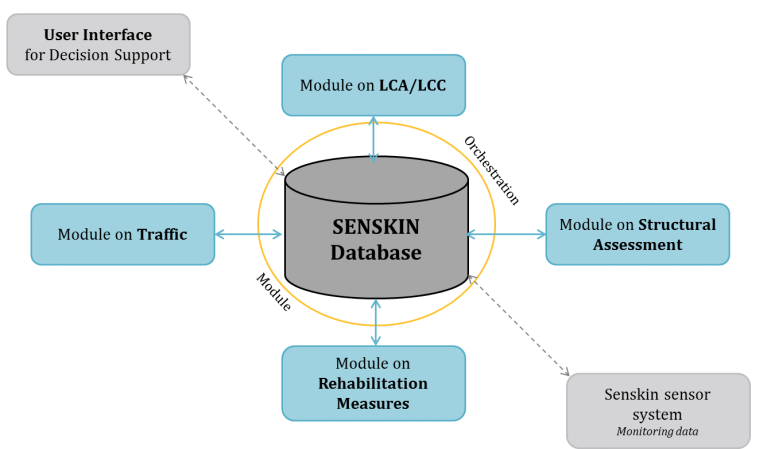Rehabilitation Planning Module, the DSS and SENSKIN Package Integration
WP6 with leader: USTUTT
WP-Partners: Institute of Communication and Computer Systems (ICCS), Egnatia Motorway S.A. (EOAE), RISA Sicherheitsanalysen GmbH (RISA), TECNIC S.p.A. (TECNIC)
WP6 develops a methodology for structural maintenance decisions that will take into account the bridge structural condition, Life Cycle Cost (LCC) analyses and Life Cycle Assessment (LCA) of available rehabilitation options as well as external effects. Furthermore, it produces a software implementation of this methodology, specified as ‘Rehabilitation Planning’ Module (RPM), which will be customized for specific conditions in Greece for field testing. The RPM will be combined with an expert system for risk assisted decision making with regard to type and time of intervention for bridge rehabilitation. The expert system will bring together sensoring and information of the new bridge monitoring system as well as link to historical, external and knowledge databases (Figure 1). RPM and expert system will form the Decision Support System (DSS) that shall provide bridge operators with rehabilitation options for proactive intervention under operating loads and intervention after extreme events, depending on the actual damage state and with regard to life cycle considerations (cost, environment).

Figure 1: Integration of RPM, Expert System and DSS (WP6)
The Rehabilitation and Planning Module as part of the DSS consists of different modular elements (Figure 2). In the Module on Structural Assessment, information about technical performance and field evaluation are assessed and made available in the SENSKIN database. Within the Module on Rehabilitation Measures, information about the damage states and rehabilitation options are defined and implemented in the database. Based on this information (e.g. damage state, necessary rehabilitation measure, necessary material, etc.) and additional LCA and LCC information (e.g. environmental profile of materials, environmental rehabilitation measures, cost profiles), a combined LCA and LCC assessment is performed for the rehabilitation options. The results feed back into the SENSKIN database and can be accessed via the user interface by practitioners. Moreover, not only the environmental and monetary impacts of the rehabilitation options but also the impact of the external effects (e.g. traffic) are assessed and displayed via the user interface. In order to provide a notion of future changes, the influence of extreme events, changes in future traffic structure and energy carriers are also assessed.

Figure 2 - Modular elements of the Rehabilitation Planning Module
Work Package Leader:

